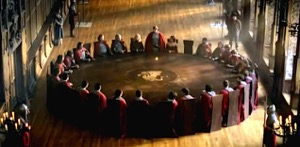Difference between revisions of "Roundtable"
m (Text replacement - "http://nordan.daynal.org" to "https://nordan.daynal.org") |
m (Text replacement - "http://" to "https://") |
||
| Line 2: | Line 2: | ||
==Origin== | ==Origin== | ||
| − | The ''Round Table'' first appears in [ | + | The ''Round Table'' first appears in [https://en.wikipedia.org/wiki/Wace Wace]'s [https://en.wikipedia.org/wiki/Roman_de_Brut ''Roman de Brut''], a [https://en.wikipedia.org/wiki/Norman_language Norman language] adaptation of Geoffrey of Monmouth's [https://en.wikipedia.org/wiki/Historia_Regum_Britanniae ''Historia Regum Britanniae''] finished in 1155. Wace says [https://en.wikipedia.org/wiki/King_Arthur Arthur] created the Round Table to prevent quarrels among his barons, none of whom would accept a lower place than the others. [https://en.wikipedia.org/wiki/Layamon Layamon] added to the story when he adapted Wace's work into the [https://nordan.daynal.org/wiki/index.php?title=English#ca._1100-1500_.09THE_MIDDLE_ENGLISH_PERIOD Middle English] Brut in the early 13th century, saying that the quarrel between Arthur's vassals led to [[violence]] at a Yuletide feast. In response a [https://en.wikipedia.org/wiki/Cornwall Cornish] carpenter built an enormous but easily transportable ''Round Table'' to prevent further [[dispute]]. Wace claims he was not the source of the ''Round Table''; both he and Layamon credited it instead to the [https://en.wikipedia.org/wiki/Bretons Bretons]. Some scholars have doubted this claim, while others believe it may be true. There is some similarity between the chroniclers' description of the ''Round Table'' and a [[custom]] recorded in Celtic stories, in which [[warriors]] sit in a [[circle]] around the [[king]] or lead warrior, in some cases feuding over the order of precedence as in Layamon. There is a possibility that Wace, contrary to his own claims, derived Arthur's round table not from any Breton source, but rather from medieval biographies of [https://en.wikipedia.org/wiki/Charlemagne Charlemagne]—notably Einhard's ''Vita Caroli'' and [https://en.wikipedia.org/wiki/Notker_the_Stammerer Notker the Stammerer]'s ''De Carolo Magno''—in which the king is said to have possessed a round table decorated with a map of [[Rome]]. |
| − | *[ | + | *[https://en.wikipedia.org/wiki/12th_century 12th Century] |
==Definitions== | ==Definitions== | ||
| − | *1: the table at which [ | + | *1: the table at which [https://en.wikipedia.org/wiki/King_Arthur King Arthur] and his [[knights]] sat so that none should have precedence. It was first mentioned in 1155. |
*2: an international [[charitable]] [[association]] that holds [[discussions]] and undertakes [[community]] [[service]]. | *2: an international [[charitable]] [[association]] that holds [[discussions]] and undertakes [[community]] [[service]]. | ||
*3: (round table) an assembly for discussion, especially at a [[conference]]: [ as modifier ] : round-table talks. | *3: (round table) an assembly for discussion, especially at a [[conference]]: [ as modifier ] : round-table talks. | ||
==Description== | ==Description== | ||
| − | The '''Round Table''' is [ | + | The '''Round Table''' is [https://en.wikipedia.org/wiki/King_Arthur King Arthur]'s famed table in the [https://en.wikipedia.org/wiki/Arthurian_legend Arthurian legend], around which he and his [[Knights]] congregate. As its name suggests, it has no head, implying that everyone who sits there has [[equal]] [[status]]. The table was first described in 1155 by [https://en.wikipedia.org/wiki/Wace Wace], who relied on previous depictions of Arthur's fabulous retinue. The [[symbolism]] of the ''Round Table'' developed over time; by the close of the 12th century it had come to represent the [[chivalric]] order associated with Arthur's court, the Knights of the Round Table.[https://en.wikipedia.org/wiki/Round_Table] |
[[Category: History]] | [[Category: History]] | ||
Latest revision as of 01:56, 13 December 2020
Origin
The Round Table first appears in Wace's Roman de Brut, a Norman language adaptation of Geoffrey of Monmouth's Historia Regum Britanniae finished in 1155. Wace says Arthur created the Round Table to prevent quarrels among his barons, none of whom would accept a lower place than the others. Layamon added to the story when he adapted Wace's work into the Middle English Brut in the early 13th century, saying that the quarrel between Arthur's vassals led to violence at a Yuletide feast. In response a Cornish carpenter built an enormous but easily transportable Round Table to prevent further dispute. Wace claims he was not the source of the Round Table; both he and Layamon credited it instead to the Bretons. Some scholars have doubted this claim, while others believe it may be true. There is some similarity between the chroniclers' description of the Round Table and a custom recorded in Celtic stories, in which warriors sit in a circle around the king or lead warrior, in some cases feuding over the order of precedence as in Layamon. There is a possibility that Wace, contrary to his own claims, derived Arthur's round table not from any Breton source, but rather from medieval biographies of Charlemagne—notably Einhard's Vita Caroli and Notker the Stammerer's De Carolo Magno—in which the king is said to have possessed a round table decorated with a map of Rome.
Definitions
- 1: the table at which King Arthur and his knights sat so that none should have precedence. It was first mentioned in 1155.
- 2: an international charitable association that holds discussions and undertakes community service.
- 3: (round table) an assembly for discussion, especially at a conference: [ as modifier ] : round-table talks.
Description
The Round Table is King Arthur's famed table in the Arthurian legend, around which he and his Knights congregate. As its name suggests, it has no head, implying that everyone who sits there has equal status. The table was first described in 1155 by Wace, who relied on previous depictions of Arthur's fabulous retinue. The symbolism of the Round Table developed over time; by the close of the 12th century it had come to represent the chivalric order associated with Arthur's court, the Knights of the Round Table.[1]
